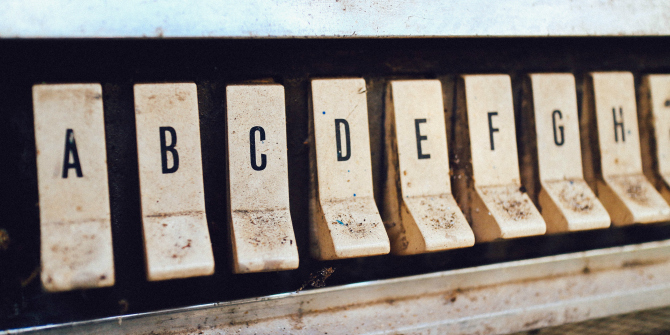 Despite most students being partly or wholly assessed on their writing, very few would consider themselves to be writers. Nonia Williams Korteling explores how students might be supported in feeling more confident about writing processes and practices in the classroom, focusing on two methods that can help students begin to see themselves as part of a community of writers: freewriting, and collaborative and discursive annotations.
Despite most students being partly or wholly assessed on their writing, very few would consider themselves to be writers. Nonia Williams Korteling explores how students might be supported in feeling more confident about writing processes and practices in the classroom, focusing on two methods that can help students begin to see themselves as part of a community of writers: freewriting, and collaborative and discursive annotations.
This post originally appeared on LSE Review of Books and is part of a series examining the material cultures of academic research, reading, and writing. If you would like to contribute to the series, please contact the managing editor of LSE Review of Books, Dr Rosemary Deller, at lsereviewofbooks@lse.ac.uk.
Creating a community of writing practice in the classroom
When I ask students, from undergraduate to PhD level, what they “do”, they seldom describe themselves as writers. As students, yes, and often in terms of the subject matter of their study, but only very rarely might someone say “I’m a writer”. And yet, most of them are assessed, in part if not wholly, on their writing. To think about how we might support students to feel more confident about their writing processes and practices, in this piece I focus on two methods that students have responded well to in terms of beginning to see themselves as writers and, in turn, as part of a community of writers. These methods are freewriting, and collaborative and discursive annotations.
One of the contexts in which I encounter students is as a learning enhancement tutor. In this role I work with a wide range of students, with disciplinary backgrounds as varied as – to name a few – nursing, business, museum studies, psychology, and education. Students often come because they are anxious about their writing. Sometimes this is to do with getting started, and sometimes to do with structuring, shaping, drafting, editing, and written expression.
Recently, I worked with a nursing student who was beginning her second-year assignment on empowerment. She was having trouble getting started, she said. She found that the practical element of her degree came more easily than the academic side; she had very little confidence in her ability to write, although her speaking about the topic was fluent, thoughtful, and perceptive. I asked the student about her current writing practice: her response focused on drafting and editing essays, but she also mentioned the reflective writing that she is required to do as part of her nursing practice.
I said I’d like her to try, right there and then, a method of writing that comes before either of these forms: this method is freewriting. I then asked her to take five minutes – without re-reading or self-correcting, and in full sentences – to respond to the prompt, “what really interests me about this topic…”. The writing would, I reassured her, be for her eyes only: a zero-draft. She wrote for several minutes without stopping, covering the page with her ideas. Afterwards, when reflecting on the exercise, the student said, with a smile, that she couldn’t believe how much she had managed to write. But she also admitted how difficult it had been, especially in terms of the discipline required to resist the urge to re-read, edit, or self-correct. (In my own practice I too find this almost impossible to resist!) We discussed how she might re-read the piece, not to correct it but to identify any key ideas that she might like to take forward; how she might use freewriting, as opposed or in addition to note-taking, as a way of processing and owning ideas from reading and research; and how fragments of freewriting might end up as the foundations for a first draft.
 Image credit: bw sunrise by Vladimer Schioshvili. This work is licensed under a CC BY-SA 2.0 license.
Image credit: bw sunrise by Vladimer Schioshvili. This work is licensed under a CC BY-SA 2.0 license.
In my experience, freewriting can really loosen up students’ approach to the writing process. It is very low stakes and, really importantly I think, connects writing to thinking and to process, as opposed to a product that will later be judged. It also enables students to see that writing is something which can come first, not something that comes after their reading and research, not something they need to wait to be “ready” to do.
When using freewriting with a group of students in a workshop or classroom scenario, I also see it as vital that I participate, because part of the point is for the experience to be a communal but solo writing practice – by using this practical writing strategy together, we are working as a community of individual practitioners. For many students, this sense of writing as shared – rather than something you struggle away with in a room on your own – is, I think, key. It demystifies and opens up the process: this is not about mystical inspiration, but about practice, strategy, trial and error. Most importantly, they’re not just talking about their writing, they’re doing it.
Another technique I use to give students this kind of experience is one of collaborative annotations. For this, I give groups of three or four students enlarged sections of text printed onto a piece of A3 or A2 paper, with plenty of surrounding space. The students will then underline, highlight, and annotate elements of the text that they’re interested in. The challenge is to make sure that they explain their thinking processes on the page – why have they selected these moments in the text? What is significant or interesting about them? What questions do they have? The groups of students then exchange annotations and respond to each others’ comments; and so it goes on, back and forth, until they have pursued their thinking about the text as far as it will go. The element of this exercise that requires the most discipline, that the students find most challenging, is the fact that they are not allowed to speak to the other groups in order to explain, expand upon or defend their thinking. All of this kind of discussion must take place in written form. These kinds of marginalia activities can take place live in the classroom, or indeed can happen online in virtual form as preparatory or supplementary work.
In my experience this method is effective because it enables students to see the writing process as a form of thinking, discussion, and modification. From the outset this writing is one that is aware of audience: this is something students can find challenging when producing summative work, but again it is this that enables them to enter into a community of practitioners in so far as our own writing and research is always a discursive process. In this way, I see it as a micro-version of our own work as well as the work that students are required to engage in with more formal pieces of written work. It is also a kind of discussion, especially in virtual form, in which even the quietest and most reticent student is able to actively engage.
Of course, the texture and timbre of these methods are constantly under revision, as my articulation and practice of them are redrafted and reshaped in the light of student and colleague feedback, their challenges, questions, and comments. In this way, these methods continue as drafts, works in progress, pieces shaped by and in communities of writing practice in the classroom.
Note: This article gives the views of the author, and not the position of the LSE Impact Blog, nor of the London School of Economics. Please review our comments policy if you have any concerns on posting a comment below.
About the author
Nonia Williams Korteling teaches in the School of Literature, Drama and Creative Writing at UEA, where she completed her PhD in 2012. She is particularly interested in researching and working with modernist-inspired 20th-century literature, women’s experimental writing, life-writing, and the essay form. Nonia is also a learning enhancement tutor at UEA, a role which enables her to work with a wide range of students from across the university. In this position her focus is on encouraging students to explore and develop their writing processes.







